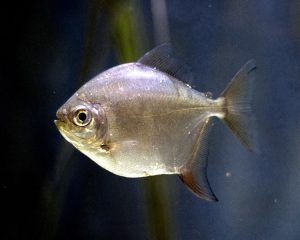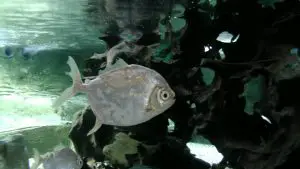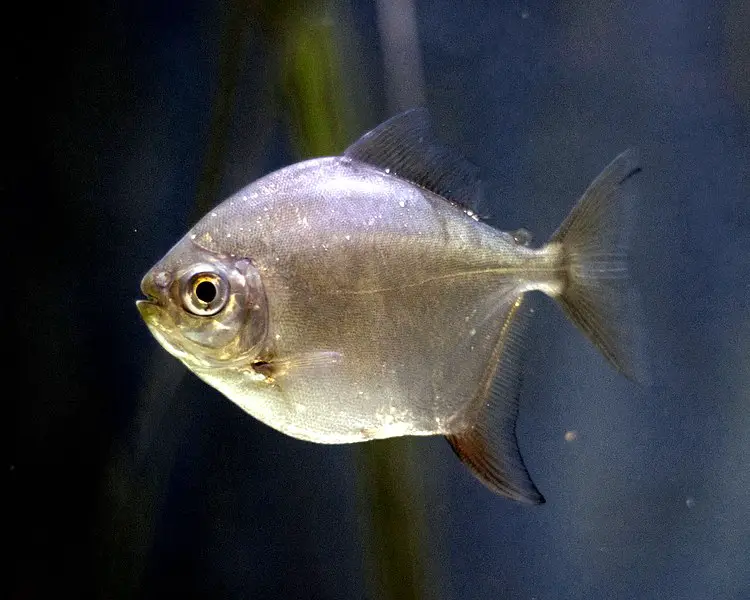Silver dollar fish is a common name given to a number of fish species that are closely related to piranha and pacu, mostly in the genus Metynnis, tropical fish belonging to the family Characidae.
If you’re a fish keeper with some experience and you’re looking to expand your collection of fish, Silver Dollar Fish could be the fish for you. They are quiet medium-sized fish, perfect for community aquariums.
These colored, silvery fish get their name from the way they look. Like an old silver dollar, they look exactly flattened laterally. They are one of the best choices when you’re looking for top water schooling fish.
These somewhat round-shaped silver fish, native to South America, are popular with hobbyist fish-keepers. The silver dollar is a peaceful species of schooling which spends most of its time in the mid- to upper water level. Its maximum lifespan exceeds 10 years.
A chin-layer, roughly 2,000 eggs will spawn the adult fish. This breeding occurs in low light, in soft, warm water. Native to the sides of weedy rivers, the silver dollars live in a tropical climate. Water with a pH of 5–7, water hardness up to 15 dGH, and an ideal temperature range of 24–28 ° C (75–82 ° F) are preferred.
Their diet is nearly exclusively vegetarian, and they will often eat all the plants in a tank in captivity. They’ll eat worms and small insects too.
Overview
Silver dollar fish, Metynnis argenteus, derive their name from their looks. They are large, silvery fish from the rivers of South America.
They belong to family Characidae, the same family as Piranha and Pacus. Unlike their more aggressive relatives, they are nonetheless peaceful herbivorous fish, perfect for large community aquariums. The silver dollar is a common name in the genus Metynnis has given to a number of different species.
Its scientific name perfectly describes the fish. Metynnis, meaning ‘with plowshare’ referring to the laterally flattened body, meaning ‘silver-covered.’ They are quite hardy fish and can live for about 10 years with good care.
They can easily be found at modest prices in pet shops and online. They are usually sold in bulk because they are best kept in groups.
Lifespan of silver dollar fish
Wondering! Silver dollar fish lifespan? The lifespan of silver dollar fish is usually 10-12 years. However, This depends upon various other factors as well.
Typical Behaviour
They are large quiet schooling fish that need plenty of space to swim. You should keep them in a minimum group of 5 people. If they are kept alone they can be quite skittish and reclusive.
Interestingly, they are pelagic fish, meaning they’ll spend most of their time swimming near the surface of the water. They easily get terrified and jump out of the tank. While they are calm fish, they can be aggressive and chase each other around the tank during eating time.
Appearance

They look as if they were an old silver dollar as the name suggests. They have a laterally flattening, round body.
Silver Dollar Fish is a generic term referring to multiple species of characin. There are two popular species Metynnis hypsauchen and Metynnis argenteus and they look very similar.
Only the black patches found behind the eyes and on the body on M are the way to spot the difference between these species. Sweetheart.
The Red Hook Silver Dollar (Myleus rubripinnis) is another common species found in the aquariums trade. They can be identified through their various shapes of coloration and fin.
Spotted Silver dollar fish
The Spotted Silver Dollar Fish is identified by the color of the silvery ground and the black dots on its body, as the name gives away. They may reach up to 6.5 inches in Brazil and French Guyana.
Red hook silver dollar fish
This fish has a distinctive red anal fin that is trimmed in black. Its coloring is far more apparent than other Silver Dollar fish.
In the wild, they can reach 22 inches, in aquariums up to 9 inches.
Habitat and tank condition
Silver dollar fish are native to South America. The waters here are dark and peat-filled. They will also have densely vegetated gravel and rocks and lots of hiding spots.
The rivers in which they live are often lined with debris such as driftwood, large rocks and weeds. Water flow in here will be moderate as far as currents are concerned.
Tank setup

Silver dollars are tropical freshwater fish-the tank should imitate as much as possible its natural environment. They will swim mainly in the middle and top part of the water column and thus need open swimming areas.
These fish are rather hardy and tolerant of different water conditions. They require water that is clean and well-oxygenated, with a good filtration system and moderate flow. A few power heads can be used to aid in water movement and oxygenation.
But make sure you don’t use glass powerheads as your Silver Dollars will be very active and the powerhead could easily be shattered.
These are jumpy fish, they always prefer a dim light and a dark background. We propose to use dark-colored gravel as a substratum. You need plenty of open space but also some hiding places around the tank’s back and sides (these can be built with large rocks and driftwood).
You should only keep plants that are not very tasty because they are herbivores; try java fern and hornwort. The alternative is to use plants that are artificial.
The water temperature with a pH of 5.5-7.5 should be kept between 75-82 ° F. You have a flexible hardness of the water between 4-18 dGH.
Tank mates
Here in this section, we will talk about the tank mates for your Silver Dollar Fish. These are large, quiet, active fish. These fish are great community fish which swim in the aquarium’s top part. If you want to add some contrast, you can look for other large, peaceful fish like catfish, which spend most of their time near the tank beds.
For starters,
These are few ideal tank mates are also ideal tank mates. Giant Danios, Pacus and Anostomus are good companions of tanks too.
We don’t advise keeping your Silver Dollars as they might be eaten with smaller fish like Gouramis, Bettas and Tetras. Shrimps and snails may be a good addition, but they may be eaten too.
Together, keeping Silver Dollar Fish
When kept together, Silver Dollars are at its best. They ‘re schooling fish so in a group they feel safer and protected.
You should aim at keeping them within a group of at least 5 people.
Silver dollar fish Feeding
Silver dollars are indeed omnivorous fish, but they prefer a herbivorous diet. They typically feed on the surrounding vegetation in nature including terrestrial plants.
A variety of plants, like lettuce, cress, chickweed, cucumber, peas and spring greens, can be fed to them. Along with large vegetable flakes you can also feed them with seaweed-like spirulina.
Spinach, carrots and fruit can also serve as an alternative source of food. They will appreciate random treatments like bloodworms, shrimp brine and boiled potatoes.
Herbivorous fish play a significant role in all major environments around the globe. Freshwater and seawater herbivore fish both help control some habitat community structures.
They prevent algae or coral from overgrowing and stealing all of the nutrients from the surrounding waters by feeding on the vegetation around them. By grazing on the surrounding plants they help to maintain a healthy and stable environment.
You should feed your Silver Dollars twice a day, offering only enough food that can be eaten at each feeding in 3 minutes or less.
Silver dollars fish Care

Silver dollars are a fairly hardy fish. As aquariums are closed systems, harmful substances such as nitrate, phosphorous and organic matter which is decomposing will develop over time.
Therefore, water should be regularly replaced and at least 25-50 percent of the water should be replaced every other week.
Although Silver Dollars are quite resilient fish, there’s no guarantee your fish won’t catch a disease or an infection. Remember, it’s a potential source of infection each time you add something new to your tank.
A clean water tank, a balanced diet and an environment that most closely resembles the natural habitats will help settle your fish making it a healthy, happy fish.
One of the most common ornamental fish diseases is an ectoparasite known as Ichthyophthirius multifiliis – more commonly referred to as white spot disease or Ich. Your fish will begin to form white spots on its gills, fins or scales.
This protozoan life cycle is highly dependent on the temperature of the water. Higher water temperatures above 77 ° F will interfere with the various stages of life and help prevent an outbreak.
Fish compatibility
The dollar of silver is listed as semi-aggressive but some dollars of silver can be very mellow. These fish can be stored in community tanks with fish that can not fit in their mouths, and once fully grown, they can be kept with larger fish such as Oscars, pikes and larger catfishes.
Breeding
Silver dollar fish breeding? This is a very common question among the aquarists. Silver dollars can be spawned in captivity relatively easily, provided they have a large comfortable environment. They are spawning in the wild in shallow waters and in heavily planted areas of flooded rivers.
You’ll need a pair of mates first.
They are always kept in a group for the best success in finding breeding pairs, raising them from juveniles to maturing. This fish usually reaches maturity about 1-year-old (approximately 4 inches in length).
You should be separating them from the rest of the school if you have a pair. You can also make spawning conditions for males and females by feeding plants and vegetables of high quality.
When the males are ready to spawn their color will be particularly darkened around the anal, caudal and dorsal fins.
You should be given a separate shallow tank of at least 40 gallons with soft warm waters for a successful spawn. Keep the temperatures around 79-82 ° F with a water hardness of 4-8 dGH, pH 6.0-7.0.
Using an air-powered sponge filter you can provide a gentle flow of water. Dim light, soft java moss spots, and surface floating plants will help during breeding. Males are about to begin chasing females around the tank.
When the females are ready to spawn, the eggs are released near or on the floating plant, and they are fertilized by the male.
The female is capable of producing up to 2000 transparent, slightly yellow eggs. Those are going to sink to the floor.
Without the parents, it’s easier to raise the fry but generally, Silver Dollars doesn’t eat their young. The eggs will hatch in about three days and after 6-9 days, the fry will be free-swimming.
You can feed the fry with infusoria-type foods until they are able to eat bigger things like small plankton, brine shrimp nauplii and vegetable flakes. In about 6-8 months Fry will be reaching adult size.
Purchasing a half-dozen juvenile silver dollars and raising them together is the best way to acquire a breeding pair. The parents won’t consume the eggs or fry, though other fish will, so it is wise to put them in a separate tank when spawning them.
Make sure that the water is soft (8 dgH or below) and warm (80 to 82 F) to facilitate spawning, keep the light dim and provide fine leavened plants.
Ultimately a pair spawns and the female lays up to 2,000 eggs. The eggs will fall to the tank ‘s bottom, where they will hatch within three days.
Conclusion
Silver dollars are hardy and freshwater tropical fish. They are large peaceful schooling fish that make the perfect addition if you want a community aquarium with good size fish.
They can be quite skittish if kept alone and are best if maintained together.
Their name, Silver Dollars, is quite a generic name referring to different species of Metynnis, different in color and size.
They are best for aquarists with some experience beforehand. They will eat whatever you give them but prefer plants and vegetables.
You may contact us here. We at Planet fish value your feedback and suggestions.


mexico drug stores pharmacies
https://cmqpharma.online/# medicine in mexico pharmacies
medicine in mexico pharmacies
Very interesting details you have mentioned, appreciate it for posting.Raise range
canadian drugs online: canadian pharmacy no scripts – safe canadian pharmacies
mexican mail order pharmacies: mexican online pharmacies prescription drugs – pharmacies in mexico that ship to usa
http://canadapharmast.com/# canada pharmacy
mexico pharmacy: mexican pharmaceuticals online – reputable mexican pharmacies online
mexican border pharmacies shipping to usa: п»їbest mexican online pharmacies – mexico pharmacy
best mail order pharmacy canada canadian pharmacy phone number best rated canadian pharmacy
my canadian pharmacy rx: trustworthy canadian pharmacy – canadian pharmacy sarasota
https://indiapharmast.com/# buy prescription drugs from india
buying prescription drugs in mexico online: mexico pharmacy – mexican mail order pharmacies
buying from online mexican pharmacy: pharmacies in mexico that ship to usa – п»їbest mexican online pharmacies
mexican border pharmacies shipping to usa purple pharmacy mexico price list mexico drug stores pharmacies
top online pharmacy india: india pharmacy mail order – india online pharmacy
india online pharmacy: buy medicines online in india – indianpharmacy com
top online pharmacy india: india pharmacy – india pharmacy
https://canadapharmast.com/# best canadian online pharmacy
http://amoxildelivery.pro/# amoxicillin without rx
http://doxycyclinedelivery.pro/# order doxycycline canada
http://doxycyclinedelivery.pro/# doxycycline over the counter
https://paxloviddelivery.pro/# paxlovid pharmacy
http://doxycyclinedelivery.pro/# vibramycin 100mg
http://clomiddelivery.pro/# can you get clomid pills
http://doxycyclinedelivery.pro/# doxycycline uk cost
https://amoxildelivery.pro/# price of amoxicillin without insurance
https://clomiddelivery.pro/# order cheap clomid